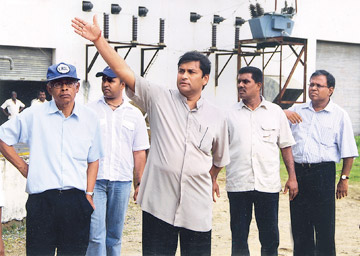Pulmoddai Mineral Sands back in business
by Shirajiv SIRIMANE
|

Minister Dayashritha Tissera visiting the plant during an
inspection tour.
|
The 30-year-old war against terrorism not only destroyed lives and
limbs, but also destroyed valuable national assets and factories. It
also destroyed the self-sufficiency of the people in the North and the
East.The Atchiveli Industrial Zone in Jaffna was also destroyed while
several other factories such as the Kankesanthurai cement plant and
Pulmoddai and Elephant Pass salterns were some of the key economic
landmarks that were left to gather dust.
With the ending of the conflict, the fisheries and agricultural
sectors have now picked up and the Elephant Pass saltern too is up and
running.
Though several attempts were made to woo an investor for the cement
plant it has not being successful so far.
The Pulmoddai Mineral Sands Factory, which was to be sold during the
UNP government, has now resumed production. The factory has the
resources to meet the demand for mineral sands.
Minister of State Resources and Enterprise Development, Dayashritha
Tissera said that the Pulmoddai deposit is one of the richest mineral
deposits in the world, with a very low cost of production. Almost five
million tonnes of ilmenite is known to be in the region, which can
theoretically be mined at the rate of 150,000 tonnes a year. In
addition, rutile and zircon can be mined at the rates of 10,000 tonnes
and 6,000 tonnes respectively.
"Tests have shown that this deposit can be used for another 150
years," the minister said.
He said there is another mineral deposit in Kokilai and they are
formulating a plan to extract minerals from this area as well.
"Unfortunately, the technology for the processing of this raw material
cannot be found within the country. Hence, most of the minerals are
exported to industrialised nations as raw material. However, we are
looking at changing this equation and process the deposits in Sri Lanka
so that the country could get more revenue", he said.
Mining in the Pulmoddai region, 52 kilometres north of Trincomalee,
came to a halt in the late nineties following the sinking by the LTTE of
two ships transporting ore, amid the escalating conflict.
The Minister said that there are 26 State institutions under this
Ministry that fall into three categories such as profit-making, those
that could be transformed into profit-making ventures, and those still
running at a loss.
There are also some institutions that remain closed. "Our aim is to
make all these profit-oriented organisations and also earn export
revenue". |

